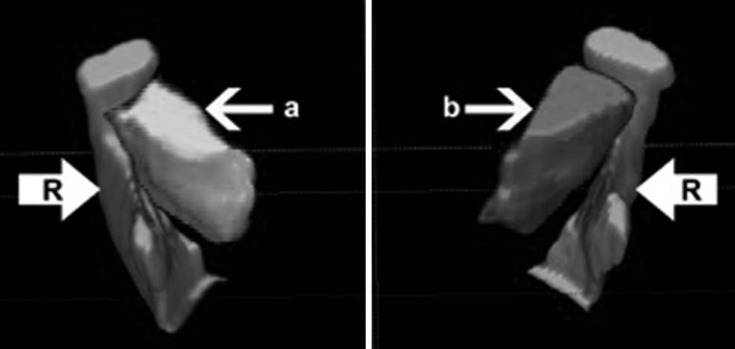Imaging Sci Dent.
2015 Mar;45(1):1-5. 10.5624/isd.2015.45.1.1.
Lateral pterygoid muscle volume and migraine in patients with temporomandibular disorders
- Affiliations
-
- 1Department of Diagnosis and Surgery, Sao Jose dos Campos Dental School, UNESP, Sao Paulo, Brazil.
- 2Department of Pediatric Dentistry and Orthodontics, University of Sao Paulo City, UNICID, Sao Paulo, Brazil.
- 3Department of Oral Diagnosis, School of Dentistry, UNICAMP, Piracicaba, Sao Paulo, Brazil. isadoraluanaflores@gmail.com
- 4Department of Specific Formation, Area of Radiology, Nova Friburgo Dental School, Fluminense Federal University, Nova Friburgo, Rio de Janeiro, Brazil.
- 5Laboratory of Neuroimaging, Department of Neurology, Faculty of Medical Sciences, UNICAMP, Campinas, Sao Paulo, Brazil.
- KMID: 2116785
- DOI: http://doi.org/10.5624/isd.2015.45.1.1
Abstract
- PURPOSE
Lateral pterygoid muscle (LPM) plays an important role in jaw movement and has been implicated in Temporomandibular disorders (TMDs). Migraine has been described as a common symptom in patients with TMDs and may be related to muscle hyperactivity. This study aimed to compare LPM volume in individuals with and without migraine, using segmentation of the LPM in magnetic resonance (MR) imaging of the TMJ.
MATERIALS AND METHODS
Twenty patients with migraine and 20 volunteers without migraine underwent a clinical examination of the TMJ, according to the Research Diagnostic Criteria for TMDs. MR imaging was performed and the LPM was segmented using the ITK-SNAP 1.4.1 software, which calculates the volume of each segmented structure in voxels per cubic millimeter. The chi-squared test and the Fisher's exact test were used to relate the TMD variables obtained from the MR images and clinical examinations to the presence of migraine. Logistic binary regression was used to determine the importance of each factor for predicting the presence of a migraine headache.
RESULTS
Patients with TMDs and migraine tended to have hypertrophy of the LPM (58.7%). In addition, abnormal mandibular movements (61.2%) and disc displacement (70.0%) were found to be the most common signs in patients with TMDs and migraine.
CONCLUSION
In patients with TMDs and simultaneous migraine, the LPM tends to be hypertrophic. LPM segmentation on MR imaging may be an alternative method to study this muscle in such patients because the hypertrophic LPM is not always palpable.
Keyword
MeSH Terms
Figure
Reference
-
1. Murray GM, Bhutada M, Peck CC, Phanachet I, Sae-Lee D, Whittle T. The human lateral pterygoid muscle. Arch Oral Biol. 2007; 52:377–380. PMID: 17141177.
Article2. Lipton RB, Bigal ME, Steiner TJ. Classification of primary headaches. Neurology. 2004; 63:427–435. PMID: 15304572.
Article3. Ballegaard V, Thede-Schmidt-Hansen P, Svensson P, Jensen R. Are headache and temporomandibular disorders related? A blinded study. Cephalalgia. 2008; 28:832–841. PMID: 18498400.
Article4. DeRossi S, Stoopler E, Sollecito T. Temporomandibular disorders and migraine headaches: comorbid conditions? Internet J Dent Sci. 2005; 2.5. Svensson P. Muscle pain in the head: overlap between temporomandibular disorders and tension-type headaches. Curr Opin Neurol. 2007; 20:320–325. PMID: 17495627.
Article6. Kreisberg MK. Headache as a symptom of craniomandibular disorders. I: Pathophysiology. Cranio. 1986; 4:135–142. PMID: 3458835.
Article7. Murray GM, Phanachet I, Uchida S, Whittle T. The role of the human lateral pterygoid muscle in the control of horizontal jaw movements. J Orofac Pain. 2001; 15:279–292. PMID: 12400398.8. Murray GM, Phanachet I, Uchida S, Whittle T. The human lateral pterygoid muscle: a review of some experimental aspects and possible clinical relevance. Aust Dent J. 2004; 49:2–8. PMID: 15104127.
Article9. Taskaya-Yilmaz N, Ceylan G, Incesu L, Muglali M. A possible etiology of the internal derangement of the temporomandibular joint based on the MRI observations of the lateral pterygoid muscle. Surg Radiol Anat. 2005; 27:19–24. PMID: 15750717.
Article10. Tasaki MM, Westesson PL. Temporomandibular joint: diagnostic accuracy with sagittal and coronal MR imaging. Radiology. 1993; 186:723–729. PMID: 8430181.
Article11. Wang MQ, Yan CY, Yuan YP. Is the superior belly of the lateral pterygoid primarily a stabilizer? An EMG study. J Oral Rehabil. 2001; 28:507–510. PMID: 11422675.
Article12. Lamey PJ, Burnett CA, Fartash L, Clifford TJ, McGovern JM. Migraine and masticatory muscle volume, bite force, and craniofacial morphology. Headache. 2001; 41:49–56. PMID: 11168603.
Article13. Türp JC, Minagi S. Palpation of the lateral pterygoid region in TMD - where is the evidence? J Dent. 2001; 29:475–483. PMID: 11809325.14. Yushkevich PA, Piven J, Hazlett HC, Smith RG, Ho S, Gee JC, et al. User-guided 3D active contour segmentation of anatomical structures: significantly improved efficiency and reliability. Neuroimage. 2006; 31:1116–1128. PMID: 16545965.
Article15. Headache Classification Subcommittee of the International Headache Society. The international classification of headache disorders. 2nd ed. Oxford: Blackwell Pub;2004. p. 9–160.16. D'Ippolito SM, Borri Wolosker AM, D'Ippolito G, Herbert de Souza B, Fenyo-Pereira M. Evaluation of the lateral pterygoid muscle using magnetic resonance imaging. Dentomaxillofac Radiol. 2010; 39:494–500. PMID: 21062943.17. Dergin G, Kilic C, Gozneli R, Yildirim D, Garip H, Moroglu S. Evaluating the correlation between the lateral pterygoid muscle attachment type and internal derangement of the temporomandibular joint with an emphasis on MR imaging findings. J Craniomaxillofac Surg. 2012; 40:459–463. PMID: 21880502.
Article
- Full Text Links
- Actions
-
Cited
- CITED
-
- Close
- Share
- Similar articles
-
- Topographic Anatomy of the Mandibular Nerve Branches Distributed on the Lateral Pterygoid Muscle
- An experimental study on the mandibular growth following resection of the lateral pterygoid muscle in rat
- Can pterygoid plate asymmetry be linked to temporomandibular joint disorders?
- Ultrasound-guided intraoral botulinum toxin injection into the lateral pterygoid muscle for chronic temporomandibular joint dislocation
- Diagnosis of headaches in dental clinic


